
i
IBM
Proud winner of ABECA 2025 - AmbitionBox Employee Choice Awards
Filter interviews by
IBM Data Scientist Interview Questions and Answers
13 Interview questions
Utilized advanced SQL queries for data analysis, aggregation, and reporting in various projects.
Used Common Table Expressions (CTEs) for recursive queries to analyze hierarchical data.
Implemented window functions like ROW_NUMBER() and RANK() for ranking patients based on their treatment outcomes.
Executed complex JOIN operations to merge data from multiple tables, enhancing data insights.
Applied subqueries for filt...
SQL queries are essential for data manipulation and retrieval in databases, enabling complex data analysis and reporting.
SELECT Statement: Used to retrieve data from a database. Example: SELECT * FROM employees WHERE department = 'Sales';
JOIN Operations: Combine rows from two or more tables based on a related column. Example: SELECT orders.id, customers.name FROM orders JOIN customers ON orders.customer_id = custo...
RAG (Retrieval-Augmented Generation) combines retrieval of relevant data with generative models for enhanced information synthesis.
RAG uses a two-step process: retrieval of relevant documents followed by generation of responses based on those documents.
It leverages large language models (LLMs) to generate contextually relevant answers, improving accuracy and relevance.
For example, in a customer support chatbot, RA...
I would rate myself a 4 in Python, with strong skills in data manipulation, analysis, and machine learning applications.
Data Manipulation: Proficient in using libraries like Pandas for data cleaning and transformation, e.g., merging datasets and handling missing values.
Data Visualization: Experienced with Matplotlib and Seaborn for creating insightful visualizations, such as scatter plots and heatmaps.
Machine Lear...
What people are saying about IBM





Python code is a programming language used for data analysis, machine learning, and scientific computing.
Python code is written in a text editor or an integrated development environment (IDE)
Python code is executed using a Python interpreter
Python code can be used for data manipulation, visualization, and modeling
Python is a high-level programming language known for its simplicity and readability.
Python is widely used for web development, data analysis, artificial intelligence, and scientific computing.
It emphasizes code readability and uses indentation for block delimiters.
Python has a large standard library and a vibrant community of developers.
Example: print('Hello, World!')
Example: import pandas as pd
Code problems refer to issues or errors in the code that need to be identified and fixed.
Code problems can include syntax errors, logical errors, or performance issues.
Examples of code problems include missing semicolons, incorrect variable assignments, or inefficient algorithms.
Identifying and resolving code problems is a key skill for data scientists to ensure accurate and efficient data analysis.
Choosing the right model depends on data characteristics, problem complexity, and performance metrics.
Model performance: Some models may outperform others based on metrics like accuracy, precision, or recall. For example, Random Forest may perform better than Logistic Regression on complex datasets.
Data characteristics: The nature of the data (e.g., linear vs. non-linear relationships) influences model choice. For...
Unit testing is a process of testing individual units of code to ensure they function correctly.
Write test cases for each unit of code
Test inputs, outputs, and edge cases
Use testing frameworks like JUnit or pytest
Automate tests to run regularly
Ensure tests are independent, isolated, and repeatable
A QnA system with LLM is a system that uses the Language Model for Information Retrieval and Question Answering.
Preprocess the input question and convert it into a format suitable for the LLM model.
Fine-tune the LLM model on a dataset of question-answer pairs.
Use the fine-tuned model to generate answers for new questions.
Evaluate the performance of the QnA system using metrics like precision, recall, and F1 score.
...
IBM Data Scientist Interview Experiences
13 interviews found
I appeared for an interview in Jun 2025, where I was asked the following questions.
- Q1. What is a rag?
- Ans.
A rag is a piece of old cloth used for cleaning or wiping surfaces, often associated with low-cost materials.
Rags can be made from various materials like cotton, linen, or synthetic fibers.
Commonly used in households for cleaning tasks, such as dusting or mopping.
In industrial settings, rags are used for wiping machinery or absorbing spills.
Rags can be repurposed from old clothing or textiles, promoting sustainability.
- Q2. How can you create a list that is reversed, with the first letter and the third letter of each item capitalized?
- Ans.
Create a reversed list with specific letters capitalized using Python.
Use a list comprehension to iterate through the original list.
Reverse the list using slicing: list[::-1].
Capitalize the first and third letters of each string using string indexing.
Example: For 'apple', it becomes 'ApPle' after processing.
- Q3. What are the various embedding techniques that you used in your project?
- Ans.
Embedding techniques transform data into numerical vectors for machine learning, enhancing model performance and interpretability.
Word2Vec: Used for natural language processing to create word embeddings based on context.
GloVe: Global Vectors for Word Representation, capturing global word co-occurrence statistics.
FastText: Extends Word2Vec by considering subword information, useful for morphologically rich languages.
BER...
- Q4. What are the advantages of using transformer models compared to traditional machine learning models?
- Ans.
Transformers excel in handling sequential data, capturing long-range dependencies, and outperforming traditional models in various tasks.
Self-attention mechanism allows transformers to weigh the importance of different words in a sentence, improving context understanding.
Transformers can process entire sequences simultaneously, unlike traditional models that often rely on sequential processing, enhancing efficiency.
The...
- Q5. What were the most effective strategies for addressing hallucinations?
- Ans.
Effective strategies to mitigate hallucinations include data validation, model fine-tuning, and user feedback integration.
Implement data validation techniques to ensure input data quality, e.g., using cross-validation.
Fine-tune models with domain-specific datasets to improve accuracy, such as using medical literature for healthcare applications.
Incorporate user feedback loops to continuously improve model outputs, e.g....
- Q6. What peft techniques which are other techniques we can used
- Ans.
PEFT techniques enhance model performance with minimal data. Other techniques include transfer learning and data augmentation.
Transfer Learning: Utilizing pre-trained models like BERT for NLP tasks.
Data Augmentation: Techniques like rotation and flipping in image datasets.
Feature Engineering: Creating new features from existing data to improve model accuracy.
Ensemble Methods: Combining multiple models to enhance predic...
I applied via Approached by Company and was interviewed in Aug 2024. There were 2 interview rounds.
*****, arjumpudi satyanarayana
(5 Questions)
- Q1. What is the python language
- Ans.
Python is a high-level programming language known for its simplicity and readability.
Python is widely used for web development, data analysis, artificial intelligence, and scientific computing.
It emphasizes code readability and uses indentation for block delimiters.
Python has a large standard library and a vibrant community of developers.
Example: print('Hello, World!')
Example: import pandas as pd
- Q2. What is the code problems
- Ans.
Code problems refer to issues or errors in the code that need to be identified and fixed.
Code problems can include syntax errors, logical errors, or performance issues.
Examples of code problems include missing semicolons, incorrect variable assignments, or inefficient algorithms.
Identifying and resolving code problems is a key skill for data scientists to ensure accurate and efficient data analysis.
- Q3. What is the python code
- Ans.
Python code is a programming language used for data analysis, machine learning, and scientific computing.
Python code is written in a text editor or an integrated development environment (IDE)
Python code is executed using a Python interpreter
Python code can be used for data manipulation, visualization, and modeling
- Q4. What is the project
- Q5. What is the lnderssip
Interview Preparation Tips
- Python
- Machine Learning
Skills evaluated in this interview
(3 Questions)
- Q1. About Machine learning basics, activation functions linear regression, cnn, all basics..
- Q2. About project questions, about sdlc basic 3 questions
- Q3. About Why not used another model for training?
- Ans.
Choosing the right model depends on data characteristics, problem complexity, and performance metrics.
Model performance: Some models may outperform others based on metrics like accuracy, precision, or recall. For example, Random Forest may perform better than Logistic Regression on complex datasets.
Data characteristics: The nature of the data (e.g., linear vs. non-linear relationships) influences model choice. For inst...
Interview Preparation Tips
DSA,ML,SQL,stats,DL,
I appeared for an interview in Mar 2025, where I was asked the following questions.
- Q1. Describe RAG approach
- Ans.
RAG (Retrieval-Augmented Generation) combines retrieval of relevant data with generative models for enhanced information synthesis.
RAG uses a two-step process: retrieval of relevant documents followed by generation of responses based on those documents.
It leverages large language models (LLMs) to generate contextually relevant answers, improving accuracy and relevance.
For example, in a customer support chatbot, RAG can...
- Q2. How to design conversational flow
- Ans.
Designing conversational flow involves structuring dialogue for clarity, engagement, and user satisfaction.
Define user goals: Understand what users want to achieve, e.g., booking an appointment.
Map out conversation paths: Create flowcharts to visualize possible dialogues.
Use natural language: Ensure the bot understands and responds in a human-like manner.
Incorporate error handling: Plan for misunderstandings and provid...
I applied via Company Website and was interviewed in Nov 2024. There was 1 interview round.
Its really easy if you know python well
60 min hackerrank test,with one mysql medium difficulty question and one python medium/little hard level difficulty
(1 Question)
- Q1. Technical covering each topic from stats, python, ml, dl, nlp,project
(1 Question)
- Q1. Project-related in-depth discussion, few case scenarios, stats question
I appeared for an interview before Mar 2024, where I was asked the following questions.
- Q1. What advanced SQL queries were used in your project?
- Ans.
Utilized advanced SQL queries for data analysis, aggregation, and reporting in various projects.
Used Common Table Expressions (CTEs) for recursive queries to analyze hierarchical data.
Implemented window functions like ROW_NUMBER() and RANK() for ranking patients based on their treatment outcomes.
Executed complex JOIN operations to merge data from multiple tables, enhancing data insights.
Applied subqueries for filtering...
- Q2. Could you please explain your project in detail?
- Q3. Window's function in SQL
- Ans.
Window functions in SQL allow for performing calculations across a set of table rows related to the current row.
Window functions operate on a set of rows defined by an OVER() clause.
They do not change the number of rows returned by a query.
Common window functions include ROW_NUMBER(), RANK(), and SUM().
Example: SELECT name, salary, RANK() OVER (ORDER BY salary DESC) AS rank FROM employees;
Window functions can be partit...
- Q4. Probability related questions
- Q5. Write some SQL queries on given situations
- Ans.
SQL queries are essential for data manipulation and retrieval in databases, enabling complex data analysis and reporting.
SELECT Statement: Used to retrieve data from a database. Example: SELECT * FROM employees WHERE department = 'Sales';
JOIN Operations: Combine rows from two or more tables based on a related column. Example: SELECT orders.id, customers.name FROM orders JOIN customers ON orders.customer_id = customers....
I applied via Company Website and was interviewed in Nov 2023. There was 1 interview round.
(1 Question)
- Q1. Can you discuss one of your project in detail and why have you chosen those specific model to start with?
I applied via Job Portal and was interviewed before Feb 2023. There was 1 interview round.
(3 Questions)
- Q1. What are hyperparameters in random forest
- Ans.
Hyperparameters in random forest are parameters that are set before the learning process begins.
Hyperparameters control the behavior of the random forest algorithm.
They are set by the data scientist and are not learned from the data.
Examples of hyperparameters in random forest include the number of trees, the maximum depth of trees, and the number of features considered at each split.
- Q2. How to do QnA system with LLM
- Ans.
A QnA system with LLM is a system that uses the Language Model for Information Retrieval and Question Answering.
Preprocess the input question and convert it into a format suitable for the LLM model.
Fine-tune the LLM model on a dataset of question-answer pairs.
Use the fine-tuned model to generate answers for new questions.
Evaluate the performance of the QnA system using metrics like precision, recall, and F1 score.
Itera...
- Q3. How to do unit testing
- Ans.
Unit testing is a process of testing individual units of code to ensure they function correctly.
Write test cases for each unit of code
Test inputs, outputs, and edge cases
Use testing frameworks like JUnit or pytest
Automate tests to run regularly
Ensure tests are independent, isolated, and repeatable
Skills evaluated in this interview
IBM Interview FAQs
Some of the top questions asked at the IBM Data Scientist interview -
The duration of IBM Data Scientist interview process can vary, but typically it takes about less than 2 weeks to complete.
Tell us how to improve this page.
IBM Interviews By Designations
- IBM Application Developer Interview Questions
- IBM Software Developer Interview Questions
- IBM Associate Systems Engineer Interview Questions
- IBM Software Engineer Interview Questions
- IBM Advisory System Analyst Interview Questions
- IBM Data Engineer Interview Questions
- IBM Senior Systems Engineer Interview Questions
- IBM Senior Software Engineer Interview Questions
- Show more
Interview Questions for Popular Designations
- Data Analyst Interview Questions
- Associate Interview Questions
- Data Engineer Interview Questions
- Senior Data Scientist Interview Questions
- Data Science Intern Interview Questions
- Decision Scientist Interview Questions
- Data Scientist Intern Interview Questions
- Data Science Analyst Interview Questions
- Show more
Overall Interview Experience Rating
based on 17 interview experiences
Difficulty level
Duration
Data Scientist Interview Questions from Similar Companies
IBM Data Scientist Reviews and Ratings
based on 62 reviews
Rating in categories
|
Application Developer
12.7k
salaries
| ₹5.3 L/yr - ₹26.8 L/yr |
|
Software Developer
6k
salaries
| ₹13.5 L/yr - ₹35.1 L/yr |
|
Software Engineer
5.9k
salaries
| ₹8.3 L/yr - ₹24.9 L/yr |
|
Senior Software Engineer
5.5k
salaries
| ₹13.2 L/yr - ₹31.7 L/yr |
|
Advisory System Analyst
4.5k
salaries
| ₹13.6 L/yr - ₹23.1 L/yr |

Oracle

TCS

Cognizant

Accenture
- Home >
- Interviews >
- IBM Interview Questions















